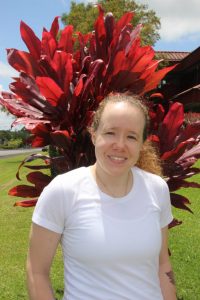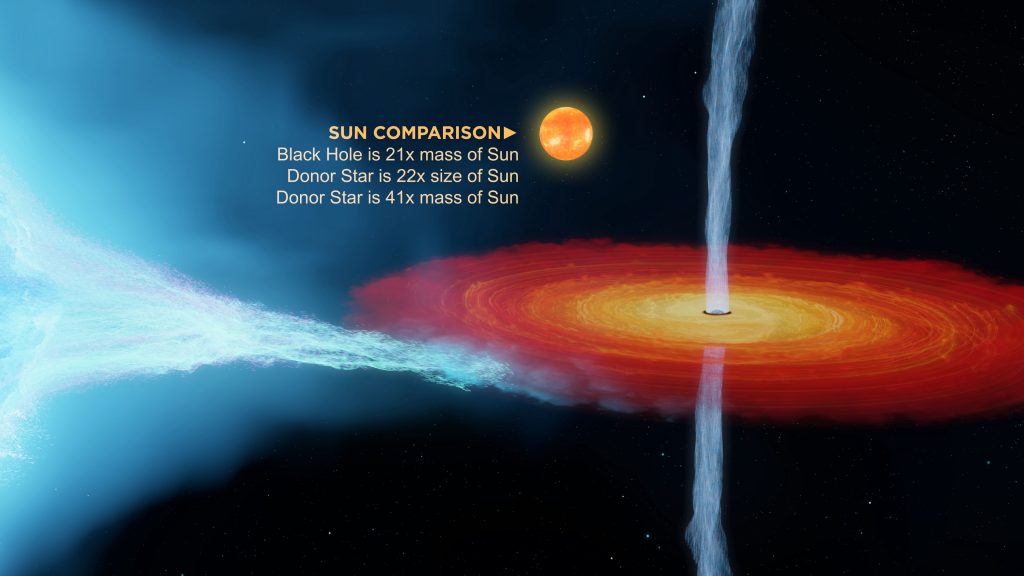Dr. Alex Tetarenko, a Hilo based astronomer who works at the James Clerk Maxwell Telescope (JCMT), has been collaborating with an international team of researchers to analyze new observations of the first black hole ever detected. Their discovery is leading astronomers to question what they know about the Universe’s most mysterious objects.

Dr. Alex Tetarenko, Credit: EAO
Published today in the journal Science, the research shows that the system known as Cygnus X-1, contains the most massive stellar-mass black hole ever detected without the use of gravitational waves. “Our new observations have shown us that Cygnus X-1 is further away from Earth than previously thought, which in turn tells us this black hole is much larger than previous estimates, weighing in at more than 20 times the mass of our own Sun” says Dr. Tetarenko.

The Cygnus X-1 binary system consists of a stellar-mass black hole that is pulling material off of a ‘donor star’. “Our new observations have shown us that Cygnus X-1 is further away from Earth than previously thought, which in turn tells us the black hole is much larger than previous estimates, weighing in at more than 20 times the mass of our own Sun.” Artist: Pete Wheeler (COMET) Credit: International Centre for Radio Astronomy Research.
Cygnus X-1 is one of the closest black holes to Earth. It was discovered in 1964 when a pair of Geiger counters were carried on board a sub-orbital rocket launched from New Mexico. This object was famously the focus of a scientific wager between physicists Stephen Hawking and Kip Thorne, with Hawking betting in 1974 that it was not a black hole and eventually conceding the bet in 1990.
In this latest work, astronomers observed a full orbit of the black hole over a six day period using the Very Long Baseline Array — a continent-sized radio telescope made up of 10 dishes spread across the United States — together with a clever technique to measure distances in space. “One of the telescopes in the Very Long Baseline Array is located in Hawaiʻi on the slopes of Maunakea, and this antenna plays a critical role in making it possible to do this kind of science” explains Dr. Tetarenko.
Lead researcher, Professor James-Miller Jones from Curtin University and the International Centre for Radio Astronomy Research (ICRAR) outlines the clever technique used by this team of researchers. “If we can view the same object from different locations, we can calculate its distance away from us by measuring how far the object appears to move relative to the background. If you hold your finger out in front of your eyes and view it with one eye at a time, you’ll notice your finger appears to jump from one spot to another. It’s exactly the same principle.”
“The domino effect of our new observations has led to fascinating new insights about how stars evolve and how black holes form” says co-author Dr. Arash Bahramian, who is also at Curtin University and ICRAR. Tetarenko and Bahramian are longtime colleagues, having both completed their PhDs at the University of Alberta in Canada.
In fact, this study has sparked two more companion papers. Co-author Professor Ilya Mandel from Monash University and the ARC Centre of Excellence in Gravitational Wave Discovery (OzGrav) further explains the wide reaching implications of this work.
“Cygnus X-1 in particular began life as a star approximately 60 times the mass of the Sun and collapsed tens of thousands of years ago. During their lifetime stars lose mass to their surrounding environment through stellar winds that blow away from their surface. But to make a black hole as heavy as Cygnus X-1, we need to dial down the amount of mass that bright stars lose during their lifetimes”.
The new measurements of distance and mass also tell us that the black hole in Cygnus X-1 is spinning incredibly quickly (very close to the speed of light), as shown in a second companion paper led by PhD candidate, Xueshan Zhao, at the Chinese Academy of Sciences.
“All of these exciting discoveries were made possible by the collaboration between a diverse group of international astronomers focused on different observational and theoretical aspects of black holes, all coming together for a new extensive and rigorous look at a known but previously elusive black hole.” adds Dr. Bahramian.
As the next generation of telescopes comes online, their improved sensitivity reveals the Universe in increasingly more detail, leveraging decades of effort invested by scientists and research teams around the world to better understand the cosmos and the exotic and extreme objects that exist.
“Studying black holes is like shining a light on the Universe’s best kept secret—it’s a challenging but incredibly exciting area of research” says Professor Miller-Jones. “There is so much left to discover about these enigmatic astrophysical objects” adds Dr. Tetarenko.
Original Publication:
‘Cygnus X-1 contains a 21-solar mass black hole – implications for massive star winds’, published in Science on February 18th, 2021.
Companion Papers:
‘Reestimating the Spin Parameter of the Black Hole in Cygnus X-1’, published in The Astrophysical Journal on February 18th, 2021.
‘Wind mass-loss rates of stripped stars inferred from Cygnus X-1’, published in The Astrophysical Journal on February 18th, 2021.
Contacts:
Dr. Alex Tetarenko, EAO Fellow, East Asian Observatory
a.tetarenko@eaobservatory.org
Dr. Jessica Dempsey, Deputy Director of the East Asian Observatory (EAO) and JCMT
j.dempsey@eaobservatory.org
Local Media Coverage



